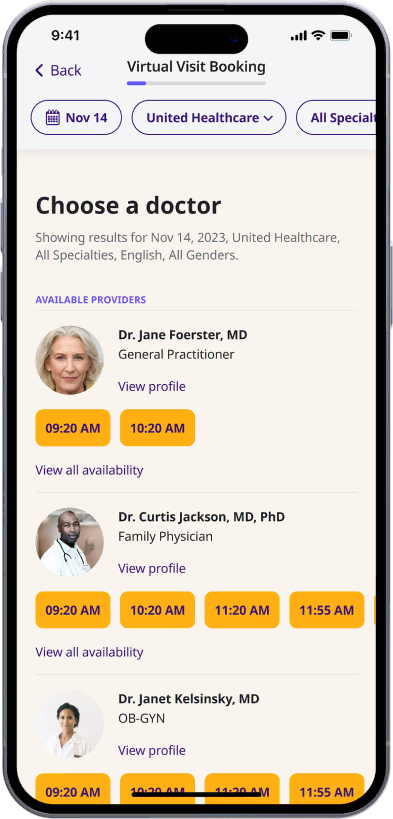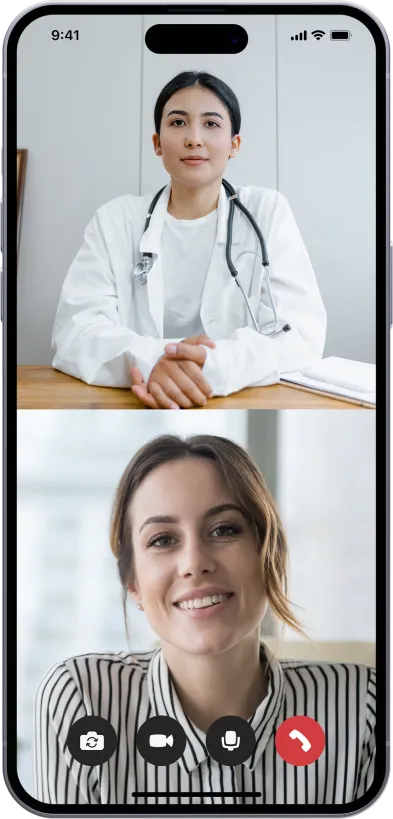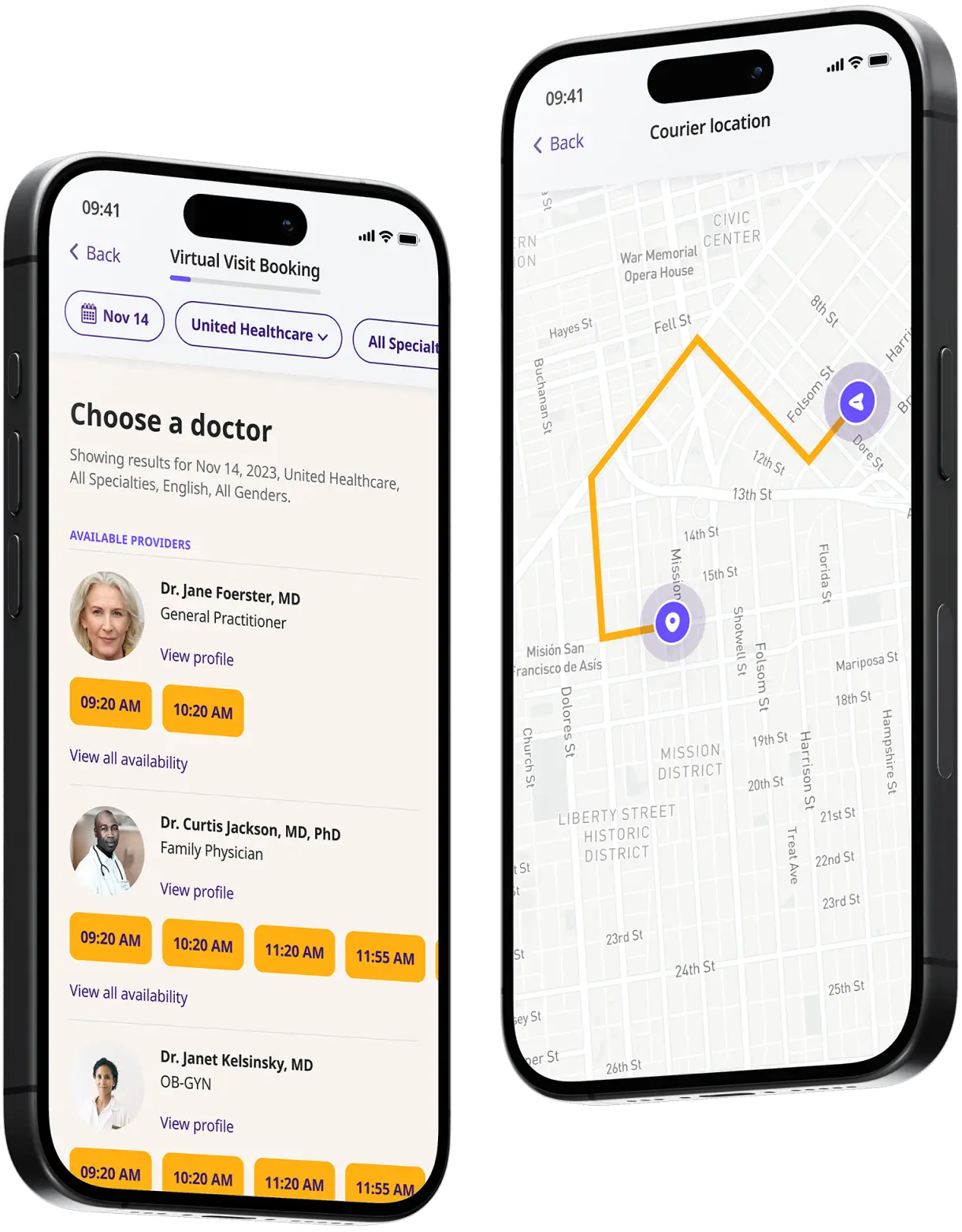Pink Eye Treatment Online
Get relief from pink eye symptoms like redness and itching. Consult an online doctor for quick and effective treatment.


Available in 50 states. Insurance accepted.
Fast
virtual visits
24/7 care
assistants
Prescriptions
as needed

24/7 Personal Care
Consult with a physician in 15 minutes, refill an Rx or chat with our care assistants.

Affordable & Convenient
See your cost upfront and get treatment for hundreds of different conditions.

Insurance Accepted
We accept most major insurance plans, making healthcare easy and affordable.
See If Delivery Is Available Near You
Delivery Not Available
Enter your ZIP code to check if prescription delivery is available in your area and how soon your meds could arrive.
How to get started
Choose your doctor, start a virtual visit, and have your prescriptions sent to your preferred pharmacy for pickup — all in just a few easy steps.
Choose a doctor
Choose a physician by availability, specialty, ratings, and more.

Start your video visit
Connect with a doctor in minutes on a secure video call.

Get your prescription
Pick up your meds or have them delivered in as little as an hour.

Available in 50 states. Insurance accepted.
One-Time
Physician Visit
One-time visit with a physician for diagnosis, treatment, Rx, labs, referrals, and doctor’s notes.
Accepted Insurances
See why people turn to DrHouse...
As seen in

Pink Eye (Conjunctivitis) Treatment Online
Pink eye, or conjunctivitis, is a common and highly contagious eye condition characterized by inflammation of the conjunctiva, the transparent membrane covering the white part of the eye and the inner eyelid.
It can affect individuals of all ages and tends to spread quickly in environments like schools and workplaces.
The condition can manifest in three main forms:
- Viral conjunctivitis: Often associated with colds and upper respiratory infections, this type is caused by a virus and is highly contagious. It usually clears up on its own within a week or two without the need for medical treatment.
- Bacterial conjunctivitis: This type is caused by bacteria and can cause serious damage if not treated promptly with antibiotics. It is also contagious and is characterized by a significant amount of sticky discharge from the eye.
- Allergic conjunctivitis: Triggered by allergens such as pollen, dust, and pet dander, this form of pink eye causes itching, redness, and excessive tearing, but it is not contagious.
Symptoms of pink eye
Pink eye, medically known as conjunctivitis, presents with several distinctive symptoms that vary slightly depending on the underlying cause—viral, bacterial, or allergic.
Recognizing these symptoms early can help in managing the condition effectively and preventing its spread.
Common symptoms include:
- Redness: The white of the eye may appear pink or red, a hallmark sign of conjunctivitis, resulting from the inflammation and dilation of tiny blood vessels within the conjunctiva.
- Itchiness: Particularly common in allergic conjunctivitis, itching can be intense and often accompanies a sensation of burning or irritation.
- Discharge: Bacterial conjunctivitis typically involves a thick, sticky discharge that can be yellow or greenish. This discharge may be heavy enough to cause the eyelids to stick together upon waking. Viral conjunctivitis also causes a watery discharge, though it is usually clearer and less copious.
- Tearing: An increase in tears is the body’s response to irritation and inflammation, commonly observed in all types of conjunctivitis.
- Sensitivity to Light: Many individuals with pink eye experience increased sensitivity to light, which can be uncomfortable or painful.
Additional considerations:
- Vision changes: While not as common, some people may experience a slight blurring of vision due to the discharge or the swelling of the conjunctiva.
- Swelling: The eyelids may become swollen and tender to the touch, especially in severe cases of allergic or bacterial conjunctivitis.
- Gritty Feeling: There might be a sensation as if something is in the eye, described often as a gritty or scratchy feeling.
Each type of conjunctivitis might share several symptoms but also has unique features that can help in identifying the cause. For instance, itching is more pronounced in allergic conjunctivitis, whereas the thick, sticky discharge is more specific to bacterial infections.
Pink eye treatment
Effective treatment of pink eye, or conjunctivitis, depends significantly on identifying the type of conjunctivitis involved—viral, bacterial, or allergic—as each type has specific treatment protocols.
Viral conjunctivitis treatment: Viral conjunctivitis typically resolves on its own within one to two weeks. Treatment is mainly supportive, focusing on alleviating symptoms:
- Cold compresses can help reduce swelling and discomfort.
- Artificial tears can soothe irritation and provide relief.
- Antihistamine or anti-inflammatory eye drops may be recommended by a healthcare provider to help manage specific symptoms such as severe itching or inflammation.
Patients are advised to maintain good hygiene, avoid touching their eyes, and change towels and bed linens frequently to prevent spreading the virus.
Bacterial conjunctivitis treatment: Bacterial infections require antibiotic treatment to clear the infection. Treatment may include:
- Antibiotic eye drops or ointments, are applied directly to the inside of the eyelid. These are typically used for several days until the infection improves and symptoms resolve.
- Oral antibiotics may be prescribed in more severe cases or if the infection is not responding to topical treatments.
Allergic conjunctivitis treatment: Allergic conjunctivitis is treated by addressing the allergies causing the reaction:
- Antihistamine eye drops can help control allergic reactions and provide relief from itching and redness.
- Oral antihistamines may be recommended for more widespread allergic symptoms.
- Avoiding allergens, such as pollen, dust mites, and pet dander, is crucial for long-term management and prevention.
Additional tips for managing conjunctivitis:
- Maintain cleanliness: Regularly wash hands, avoid sharing personal items like towels and face cloths, and clean surfaces such as countertops and doorknobs.
- Avoid eye makeup and contact lenses: While experiencing symptoms, avoid using makeup and contact lenses to prevent further irritation or spread of the infection.
In cases where symptoms persist or worsen, it is important to consult a healthcare provider to reassess the condition and adjust treatment accordingly.
Medication for pink eye
Medications for pink eye (conjunctivitis) are primarily aimed at alleviating symptoms and addressing the underlying cause of the inflammation. The choice of medication depends significantly on whether the conjunctivitis is viral, bacterial, or allergic.
Viral conjunctivitis: There are no specific antiviral medications for most causes of viral conjunctivitis. Instead, treatment focuses on symptom relief:
- Lubricating eye drops (artificial tears) can help alleviate dryness and irritation.
- Steroid eye drops might be prescribed in severe cases to reduce inflammation, under close medical supervision.
Bacterial conjunctivitis: Antibiotics are required to treat this infection.
- Antibiotic eye drops or ointments, such as Polymyxin B-Trimethoprim (Polytrim), are commonly prescribed to eliminate the bacterial infection.
- Oral antibiotics might be considered for more extensive infections or for cases not responding to topical treatment.
Allergic conjunctivitis: Treatment is directed at controlling allergies and inflammation.
- Antihistamine eye drops such as Ketotifen can quickly relieve itching and redness.
- Mast cell stabilizers like Cromolyn can be used for long-term prevention.
- Non-steroidal anti-inflammatory drugs (NSAIDs) eye drops may also be used to decrease swelling and pain.
When to see a doctor?
It’s important to consult a doctor for pink eye in certain situations to ensure appropriate treatment and prevent complications. You should see a doctor if:
- Symptoms persist or worsen despite treatment.
- There is moderate to severe pain in the eye.
- Vision becomes blurry or you experience sensitivity to light.
- Symptoms are accompanied by intense redness in the eyes.
- There is a significant amount of pus or discharge, suggesting a bacterial infection.
Additionally, if you have pre-existing eye conditions or a weakened immune system, seeking medical advice early can help manage the condition more effectively.
How can DrHouse help you?
DrHouse can assist with pink eye by providing quick and convenient telehealth services. Through our online platform, you can consult with healthcare professionals who can diagnose your symptoms, prescribe necessary medications, and offer advice on managing and preventing pink eye.
Frequently asked questions (FAQ)
Can pink eye be treated with telehealth?
Yes, pink eye can be treated through telehealth. Our platform allows you to consult with a healthcare professional who can diagnose and prescribe necessary medications for treatment.
Is it safe to get pink eye treatment online?
Yes, DrHouse provides secure and confidential telehealth services. Our healthcare professionals are licensed and experienced in treating a variety of conditions, including pink eye.
Frequently asked questions




